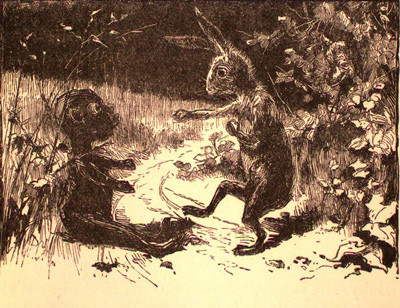Americana: Georgia
22 Apr - 10 May 2008
AMERICANA: GEORGIA
Br'er Rabbit's Narrative Trap
Mary Augustine Gallery
Apr. 22–May 10, 2008
In 1881, Georgia-native Joel Chandler Harris published his book Uncle Remus: His Songs and His Sayings, The Folk-Lore of the Old Plantation to almost overnight success. Culled from his years of working on plantations when he spent evenings listening to slaves share their stories, Harris presents a collection of cautionary tales. Often carrying a moral lesson, these stories are set in the Georgia landscape and filled with mischievous and wily characters who take the form of animals.
Although people had attempted to publish these stories before, Harris was the first to bring the tales to a wider audience and capture the dialect in which the stories were originally told. While Harris asserted that the stories belonged to the slaves, he remains credited with their authorship. Harris takes further ownership of the stories in his creation of the fictional character Uncle Remus, the narrator. The stories were created for a white audience, for the fictional white boy from the plantation who sits in Uncle Remus's room at night listening to the stories, as well as those who were privileged enough to be able to read.
One of the most well-known stories of the Uncle Remus series, and the most controversial, is that of The Wonderful Tar Baby, wherein Br'er Rabbit, often depicted as the underdog in the Uncle Remus stories, gets caught in a tar trap that Br'er Fox set for him. Symbolically the rabbit is often read as the slave character, but due to his ability to outsmart his master he is set free in the end.
Harris's manifestation of these tales became fixed in folk history, as is apparent from Disney's adapted Uncle Remus tales in making Song of the South, released in 1948. The film grossed millions of dollars and was re-released several times until, after its last release in 1986, its subject matter was seen as racist. Our knowledge of these stories now exists predominantly as Harris and Disney interpreted them, rather than passed down through the oral storytelling tradition in which they were originally conceived.
This exhibition presents rare audio versions of the Br'er Rabbit stories told in the oral storytelling style from which they originated. In the vitrine are excerpts and illustrations from Harris's book, and ephemera produced for Disney's Song of the South. The ever-changing form of oral storytelling is juxtaposed with the fixed narrative in the book, challenging the publication in its authenticity and authority.
Kate Phillimore
Br'er Rabbit's Narrative Trap
Mary Augustine Gallery
Apr. 22–May 10, 2008
In 1881, Georgia-native Joel Chandler Harris published his book Uncle Remus: His Songs and His Sayings, The Folk-Lore of the Old Plantation to almost overnight success. Culled from his years of working on plantations when he spent evenings listening to slaves share their stories, Harris presents a collection of cautionary tales. Often carrying a moral lesson, these stories are set in the Georgia landscape and filled with mischievous and wily characters who take the form of animals.
Although people had attempted to publish these stories before, Harris was the first to bring the tales to a wider audience and capture the dialect in which the stories were originally told. While Harris asserted that the stories belonged to the slaves, he remains credited with their authorship. Harris takes further ownership of the stories in his creation of the fictional character Uncle Remus, the narrator. The stories were created for a white audience, for the fictional white boy from the plantation who sits in Uncle Remus's room at night listening to the stories, as well as those who were privileged enough to be able to read.
One of the most well-known stories of the Uncle Remus series, and the most controversial, is that of The Wonderful Tar Baby, wherein Br'er Rabbit, often depicted as the underdog in the Uncle Remus stories, gets caught in a tar trap that Br'er Fox set for him. Symbolically the rabbit is often read as the slave character, but due to his ability to outsmart his master he is set free in the end.
Harris's manifestation of these tales became fixed in folk history, as is apparent from Disney's adapted Uncle Remus tales in making Song of the South, released in 1948. The film grossed millions of dollars and was re-released several times until, after its last release in 1986, its subject matter was seen as racist. Our knowledge of these stories now exists predominantly as Harris and Disney interpreted them, rather than passed down through the oral storytelling tradition in which they were originally conceived.
This exhibition presents rare audio versions of the Br'er Rabbit stories told in the oral storytelling style from which they originated. In the vitrine are excerpts and illustrations from Harris's book, and ephemera produced for Disney's Song of the South. The ever-changing form of oral storytelling is juxtaposed with the fixed narrative in the book, challenging the publication in its authenticity and authority.
Kate Phillimore

